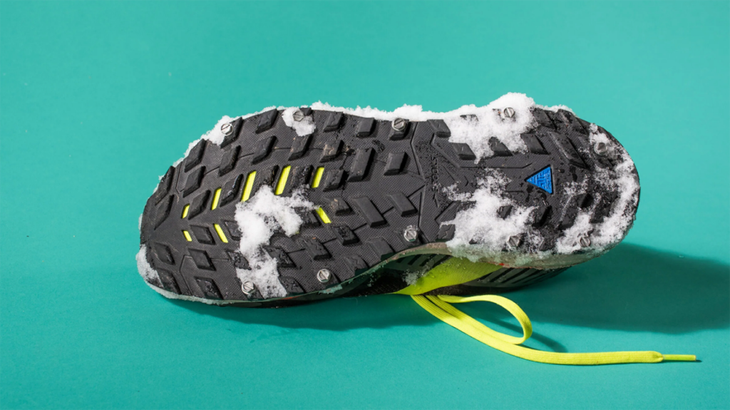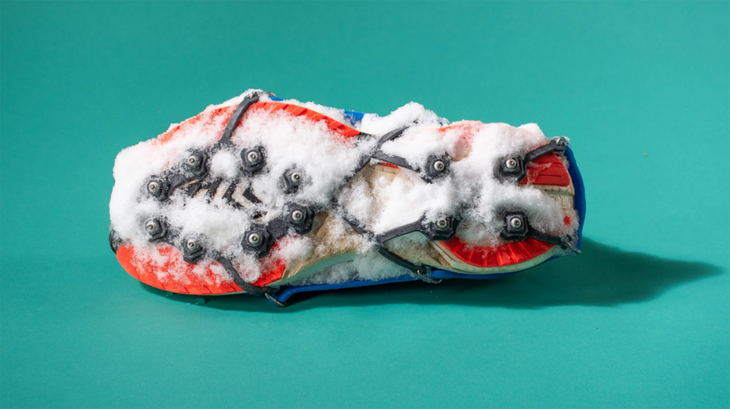If you buy through our links, we may earn an affiliate commission. This supports our mission to get more people active and outside.Learn about Outside Online's affiliate link policy
Three Smart Options to Enhance Traction for Winter Running

For about $5 and 15 minutes of work, you can turn any pair of running shoes into a pair of reliable winter running cleats.
If you live in a region where winter conditions—namely, snow, ice, and slush—make it tough to run outdoors because of slippery footing, you can invest in enhanced traction so you can keep training consistently. While you can sometimes get by running through snow and slush just by wearing trail running shoes with knobby rubber outsole lugs, there are three primary ways to improve your traction for winter running on snowy and icy wintry surfaces, ranging from affordable to relatively expensive.
You only need to spend a couple of bucks to put DIY studs into your shoes via traction-grabbing hex-head sheet metal screws. “Studs are good for just about any situation where there’s ice and snow, even as a ‘just in case,’” says James Dooley, a staffer at Skinny Raven Sports in Anchorage, Alaska, which helps its customers stud their own shoes every winter. “They’re really effective when it comes to black ice.”
An old pair of road trainers can get an extended life as reliable winter running shoes simply by inserting metal screws around the perimeter of the outsole to create custom spiked shoes.
RELATED: Why Runners Should Treat Winter as a Training Tool
Similar Reads
DIY: How to Screw Spikes into Your Running Shoes
Winterizing your shoes with screws can be inexpensive, but it takes some effort and know-how to do it well. Start by buying a small box of ½-inch #6 hex head sheet metal screws at your local hardware store or home improvement center. (That should cost less than $5 if you get at least 8-10 for each shoe). Then mark out where you’ll insert the screws around the shoe. It’s best to place them only in the perimeter of the shoe, even though most well-cushioned shoes have a thick enough midsole that would keep them from poking the bottom of your feet.

Use a 1/16” diameter drill bit to pre-drill starter holes for the screws, or start the process by pushing a nail or thick pin or needle into the first layer of the outsole. Twist the pointy end of a screw into the hole to get started, then use a (powered or manual) screwdriver to submerge the screw into the shoe so the flange is flush with the outsole. Repeat that 8 to 10 times in each shoe and, just like that, you’ve made yourself some studded shoes.
For more aggressive traction, consider getting an Ice Spike kit for about $20-$25, or a La Sportiva Hobnails kit for $59.
It’s important to note that none of these DIY options are perfect solutions for everyday winter running, because those screws can fall out or get torn out and running on smooth, dry surfaces can feel awkward. But they can usually get you through the season, and that’s all most runners really need. However, if you’re looking for a hardier solution, try getting a pair of dedicated winter running shoes. (See below.)
Supplemental Traction Accessories for Winter Running
Like snow chains for the tires on your car or truck, after-market over-spikes pull over your shoes and provide better grip. Winter running spikes offer improved traction, though they can feel slightly awkward under your feet, especially on harder and smoother surfaces. That’s because there is a bit of a disruption of the foot-to-ground proprioceptive connection that’s typically not present when your soft rubber outsoles are smoothly rolling off the road.

The Yaktrax Winter Run Traction Device ($45) is best for running on snowy roads. It provides traction from metal wire coiled around a stretchy elastomer frame that criss-crosses the bottom of the shoe.
Black Diamond’s Distance Spike ($99) is great on snowy roads or trails. The spikes are essentially a running-specific crampon device that includes a series of five aggressive metal claws connected by a small metal chain under the shoe and an elastic rubberized frame that is secured over the top of the shoe.
For running or hiking through deeper snow, try Kahtoola MICROspikes ($75). Almost identical to the Black Diamond product, the Kahtoola MICROspikes are slightly beefier and heavier. Kahtoola also makes a multi-purpose EXOspikes ($63) and a great option for hard-packed snow, Kahtoola NANOspikes ($55). Each model is slightly different in its design, so consider which winter running spikes are best for the conditions you’ll be facing most often.
Winter Running Shoes for Snow and Ice
There are numerous winter running shoes with spikes embedded in their outsoles for runners who often find themselves on icy and snowy roads, bike paths and trails. They may be overkill for standard trail usage, however. Though they’ll run pretty well on mostly dirt trails, these winter spiked shoes can actually be slippery on trails with a lot of rocks.

There are a few brands that make these specialty winter running shoes, with some of the top models being the Norda 001 G+ Spike ($270), Salomon Spikecross 6 Gore-Tex ($190) and IceBug Arcus 2 BugGrip GTX ($220).
Each of those are rugged trail running shoes that have been enhanced with traction from tiny, carbide tipped metal spikes embedded in the outsole. They’re moderately expensive, but if you’re only running in them 25 to 50 times every winter, they’ll definitely last for many seasons.


